A fish and frog pond is always a welcome addition to any setting. However, ponds are prone to quickly becoming a breeding ground for mosquitoes and it’s important to know what you can and cannot use to kill them, especially if you have fish or frogs in your pond.
Mosquitoes can be killed in ponds without harming fish or frogs using bacterial larvicides or insect growth regulators. Mosquito predators including fish and dragonflies (and their larvae) will also kill mosquitoes in your fish or frog pond naturally.
This guide covers everything you need to know about how to get rid of mosquitoes in ponds – without killing your your fish or frogs. This includes which bacterial larvicides and insect growth regulators actually work, how long they last, and if they are safe for your pond critters. We also cover prevention measures you can take including natural ways to kill mosquitoes in fish and frog ponds. Plus TONs more!
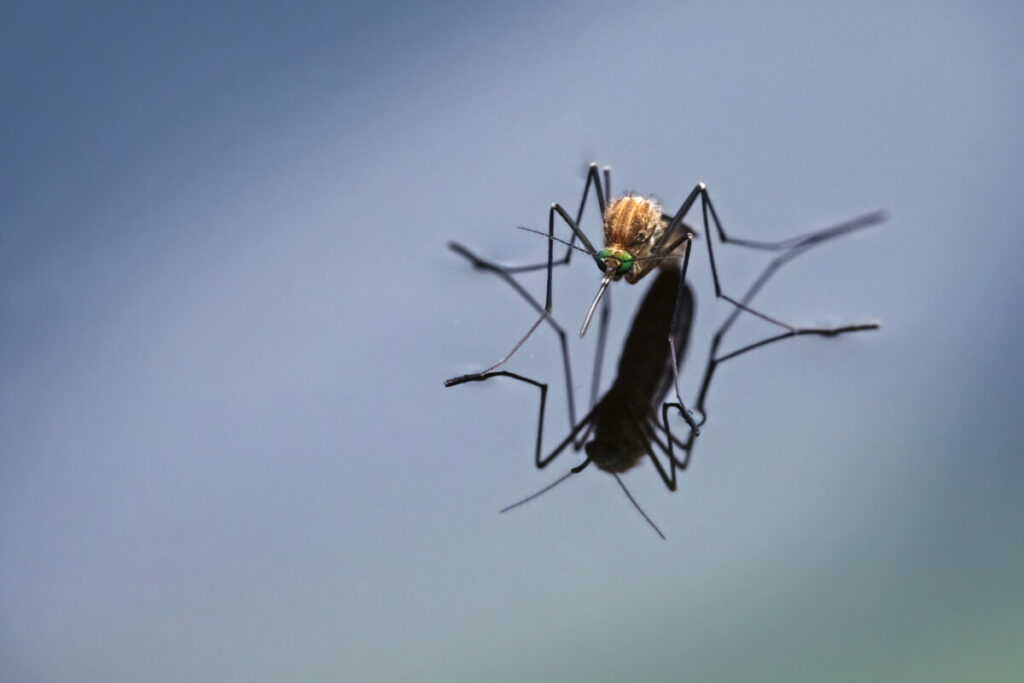
Larvicides That Kill Mosquitoes – Without Harming Fish Or Frogs
Larvicides can specifically target the mosquito larvae in your pond. Larvae are like the infant version of mosquitoes, they haven’t reached puberty or adulthood yet, and it’s best to kill them at this stage, before they mature.
There are three types of larvicides:
- Oils and films
- Bacterial larvicides
- Insect growth regulators.
If you also have mosquitoes breeding in your pool then you need to take a different approach, Water Purification Guide has more information on how to remove them available here.
Oils and films
You should NEVER use any form of oil or film if you have fish or frogs in your pond, such as:
- Cinnamon oil
- Mineral oil
- Cooking oils of any kind
- Paraffin oil
- Kerosene
- Soap
Adding chlorine is also NOT recommended if you have fish or frogs.
Bacterial larvicides
In general, bacterial larvicide products that are safe for your fish, frogs and tadpoles will often have active ingredients including one or more of the following bacteria species:
| Bacteria species | Products |
| Bacillus thuringiensis subsp. israelensis (BTI) | Mosquito Dunks Mosquito Bits Bonide Mosquito Beater Terro mosquito pouches |
| Bacillus sphaericus 2362 | Terro mosquito pouches |
| Lactobacillus acidophilus (probiotic bacteria) | Apple cider vinegar |
| Saccharopolyspora spinosa | Natural DT Mosquito Killer |
Insect growth regulators
(S)-Methoprene is a biochemical pesticide that works as an insect growth regulator to interfere with the mosquito’s growth and development.
Products that contain (S)-Methoprene and are safe for both fish and frogs include:
- Mosquito Torpedo
- Altosid Pro-G Mosquito Larvicide
Best Mosquito Killers For Fish And Frog Ponds
The best mosquito killers for fish and frog ponds can be readily available for you – all it takes is either one trip to the nearest supermarket, or a click to make an order from Amazon. In fact, some of these mosquito “killers” may be something you already have at home!
Mosquito Dunks
Mosquito Dunks are small, doughnut-like items that you drop in the pond to kill mosquito larvae. As it slowly dissolves in the water, the Bacillus thuringiensis subsp. israelensis (BTI) active ingredient is lethal to mosquito larvae but is harmless to other organisms including fish, frogs, and tadpoles.
Each application of a Dunk helps keep your pond larvae-free for at least 30 days.
Price: $10.00 (this is for a pack of 6 on Amazon, so that’s roughly $1.60 per month)
Mosquito Bits
Mosquito Bits work the same way as a Dunk. It dissolves in water and uses Bacillus thuringiensis subsp. israelensis (BTI) to kill off mosquito larvae but is harmless to your fish, frogs, and tadpoles.
What makes the Bits different is it acts quicker than the Dunk but requires a more frequent application to keep the effect and protection on your pond going. The recommended application is at least bi-weekly.
Price: $16.99–$119.00 (on Amazon – price ranges depending on amount needed for your pond volume)
Bonide Mosquito Beater
The Bonide Mosquito Beater is a water double mosquito larvae killer that uses Bacillus thuringiensis subsp. israelensis (BTI) as its active ingredient. This means that the product is also safe for other living organisms including fish and amphibians (including tadpoles) in or around your pond.
Each pouch is able to kill larvae up to 50 meters deep and give protection for up to two weeks.
Price: from $14.00 on Amazon
Terro No Mess Mosquito Larvacide Pouch
Terro mosquito pouches are a long-lasting larvae killer that is perfectly safe for use in fish and frog ponds. Each pouch can kill mosquito larvae and protect the stagnant water from any further infestation for up to two months.
The Terro mosquito pouches contain two active ingredient bacteria, Bacillus sphaericus 2362 and Bacillus thuringiensis subsp. israelensis (BTI). Together, these bacteria damage and paralyze the gut of the mosquito larvae, causing the larvae to starve.
It is recommended you use one pouch per 50 square feet of treatment area.
Price: starts at $11.00 for 10 pouches on Amazon (that’s nearly 2 years of mosquito protection! You many need to use more for larger ponds)
Clarke – Natular DT Mosquito Larvicide
Another water-soluble product, the Natural DT Mosquito Killer by Clarke starts working within 24 hours, and each tablet can treat up to 50 gallons worth of water. It active ingredient (spinosad) is a larvicide that kills off any existing mosquito larvae and prevents any new larvae from establishing using in your pond for up to 60 days.
Spinosad is a natural substance made by a soil bacterium that is toxic to mosquito larvae. It attacks their nervous system, causing them to die.
Natular DT Mosquito larvicide is safe for fish and frog ponds, including frog eggs and tadpoles. It is also safe for your pond plants.
Note: Spinsosad is very toxic to bees. So, if you regularly get bees visiting your pond, it’s probably best if you choose a different product.
Price: $17.00 for 12 tablets on Amazon (this 12-pack gives you nearly 2 years of protection, depending on your pond volume)
Mosquito Torpedo 5PK by PRE Strike
The Mosquito Torpedo also works by dissolving in water and is safe for fish and frogs. Once dissolved, it continuously releases an environmentally-friendly Insect Growth Regulator, (S)-Methoprene, that works by killing off any new larvae in the water for the next 60 days.
Note: (S)-Methoprene does not work on mosquitoes that have already reached the pupal or adult live stages and only affects the larvae. However, regular treatments means no larvae will ever become pupae or adult mosquitoes.
You’ll need about 1-2 torpedo’s per 1,500 gallons of water.
Price: starts at $10 on Amazon (roughly 10 months protection, depending on you pond volume)
Altosid Pro-G Mosquito Larvicide
Altosid Pro-G Mosquito Larvicide is a fine granulated mosquito larvicide that is safe for fish according to the manufacturers (Zoecon). The active ingredient in Altosid Pro-G is (S)-methoprene, which is an insect growth regulator and is effective against mosquito larvae for around 30 days after application.
Be aware that Altosid Pro-G HAS NO effect on mosquitoes that have already reached the pupal or adult life stages prior to treatment, but it WILL stop mosquito larvae mosquito from turning into mosquito pupae and adults.
This larvicide is also safe for pets and other wildlife. Although the company do not specifically state that Altosid Pro-G is ok for frogs, methoprene is known to have a very low toxicity to amphibians especially at this low concentration.
A 2.5 pound bottle of Altosid granules treats approximately 20,000 gallons of water. You need just one quarter teaspoon per 50 gallons. See the product label for correct application rate.
Price: $45 on Amazon
Apple cider vinegar
Apple cider vinegar is effective against mosquito larvae. Apple cider vinegar contains a probiotic bacteria, Lactobacillus acidophilus, that kills the mosquito larvae, but has no effect on your fish, frogs, or plants.
Importantly, distilled white vinegar does not contain this bacteria, so will not be effective at killing mosquito larvae.
Simply add the correct amount of apple cider vinegar in proportion to the amount of water being treated, as follows:
- Use 15 percent apple cider vinegar for every 85 percent water.
- That’s roughly 110 fl oz apple cider vinegar per gallon of water (or 150 mL vinegar per litre of water).
- Mix it through and leave for at least 18 hours. It should have killed all larvae in the water by then.
If you’re not sure of the exact amount of water in your fish or frog pond, try and add at least one sixth of the total water volume. You can always add more later if the mosquito wrigglers (larvae) are still alive.
Importantly, you would not use this method if you are treating a large pond – it would be WAY too expensive!
But if you are treating a small body of water, such as a small fountain, or a pot pond, then adding apple cider vinegar can work well. A much more affordable option for larger ponds is to use any one of the larvicides mentioned above.
You can get any brand of apple cider vinegar from your nearest grocery or supermarket.
Price: $35.00 for 1 gallon on Amazon
What NOT To Use To Kill Mosquito Larvae In Ponds With Fish Or Frogs?
Aside from chemical larvicides that may kill your fish and frogs, there are some other DIY remedies that may not be safe for your little pond critters.
Bleach
Bleach is an easy way to kill off larvae. However, adding bleach in your pond water will also pose a threat to your fish or frogs living in it. So, avoid using bleach in any form – be it in liquid, powder, or tablet.
Dish Soap Or Shampoo
A good amount of dish soap can get rid of any existing larvae in any stagnant water. Soap works at killing mosquito larvae by changing the surface tension of the water, which stops them being able to breath air from the surface and eventually causing them to drown.
However, if it is used in a fish or frog pond, the soap in these products may be toxic.
Oils
A good amount of vegetable oil, extra virgin olive oil, or mineral oil can kill mosquito larvae, but the oil may have an adverse effect on fish and frogs. So, it would be better to stay away from these methods so as not to endanger your little water critters.
Does Dumping Water Kill Mosquito Larvae?
One of the most common things people think of first in dealing with mosquitoes is dumping the water out. After all, mosquito larvae need stagnant water to thrive and without it, adult mosquitoes would not have any place to lay their eggs.
Dumping the infested body of water and clearing it out would instantly solve all of your mosquito problems.
This method of control applies to situations such as plant pots, old tires, old containers, and the like. However, it may not be the best option if you are dealing with a pond, especially if you have several fish and tadpoles in it already.
The good news is that you can still effectively control this pest without the need to damage your pond and disrupt the habitat of your fish and frogs. All it takes is the proper know-how, and the correct product to make it possible.
Fish Ponds – How to get rid of mosquitoes in a fish pond naturally
There is an easy and natural way to get rid of mosquitoes in a fish pond.
Invite the predators!
Some fish species, dragonflies and dragonfly larvae (nymphs), are great at eating adult mosquitoes as well as mosquito larvae.
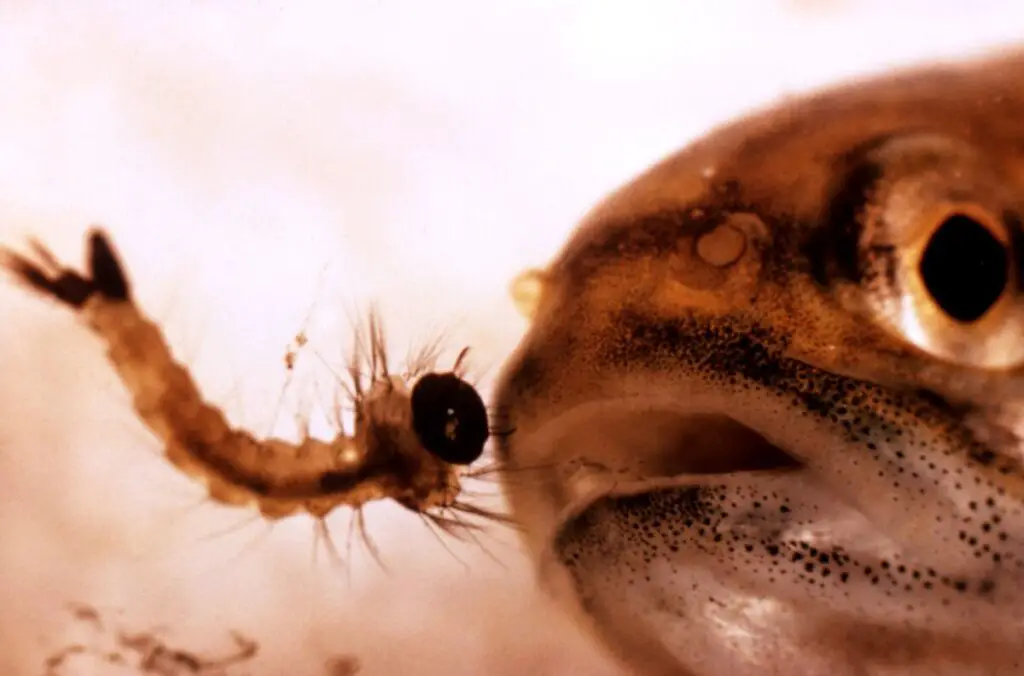
Get the right fish in your pond
Did you know that there are specific types of fish that actually eat mosquito larvae? These fish species can act not only as a member of your pond but also as a natural way of pest control.
If you already have them in your pond, then that is already a good thing. If you still don’t, or you’re not sure which fish can do this job for you, here are some helpful critters that are out there for mosquitoes larvae just as much as you are.
Here are some types of fish that can help you clear your pond of mosquito larvae:
- Killifish
- Topminnows
- Goldfish
- Bass
- Guppies
- Bluegill
- Catfish
The western mosquitofish (Gambusia affinis) is considered by experts to be the most effective fish against mosquito larvae and is actually deployed by some professionals in areas where infestation had been on a serious level.
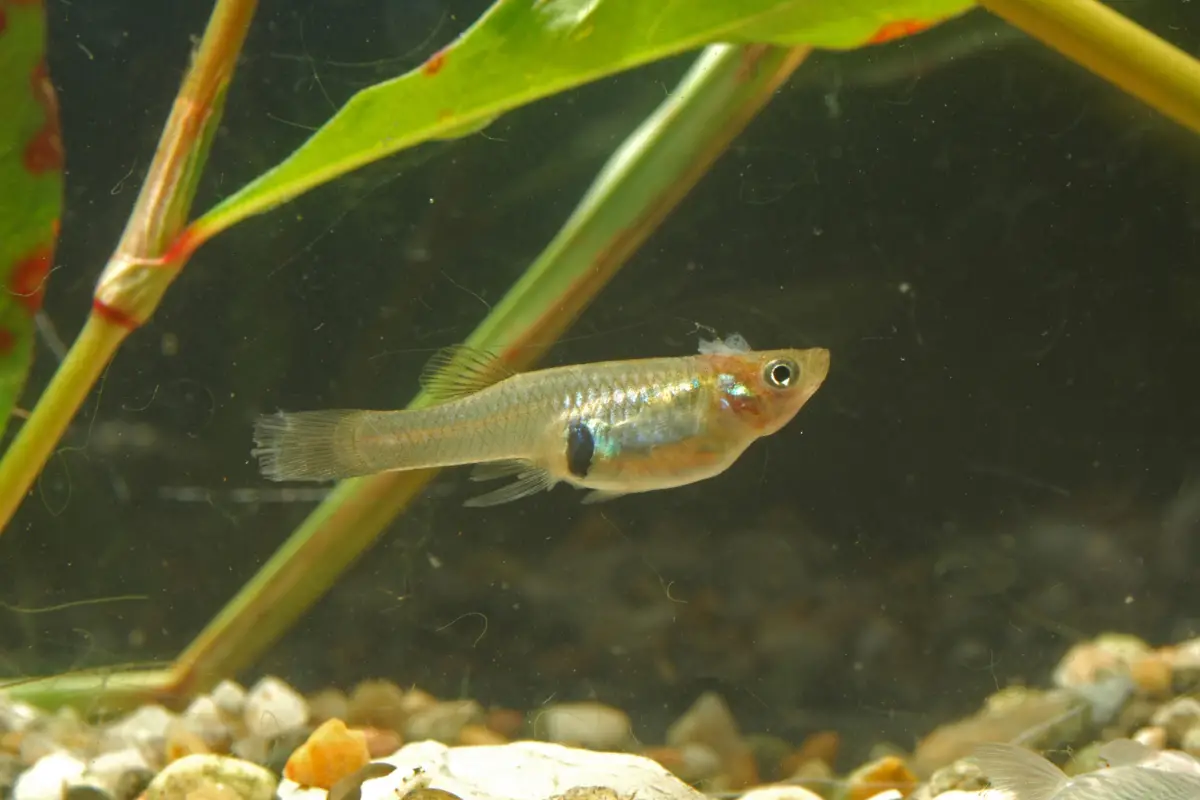
However, the mosquitofish is a highly invasive species and can actually be harmful to other smaller fish since it eats them and food competition can be harmful to less aggressive fish species, too.
Encourage dragonflies
Dragonfies and dragonfly larvae (nymphs) are veracious mosquito killers! By developing your pond area to include plants that attract dragonflies and providing water plants where they can lay their eggs can be powerful and natural way to keep mosquito populations low.
Plants that encourage dragonfly include:
- Joe-Pye Weed (Eupatorium purpureum)
- Coneflowers (Echinacea)
- Yarrow (Archillea)
- Meadow Sage (Salvia marcus)
- Borage (Borago officinalis)
- Black-Eyed Susan (Redbeckia hirta)
- Swamp Milkweed (Asclepias incamata)
Plants that encourage dragonflies to lay eggs in water include:
- Water lilies (Nymphaea) – aquatic / emergent plants
- Arrowhead (Sagittaria latifolia) – aquatic plant
- Water Horsetail (Equisetum) – aquatic / emergent plant
- Pickerel Rush (Pontederia cordata) – aquatic / emergent plant
- Wild Celery (Vallisneria americana) – aquatic plant
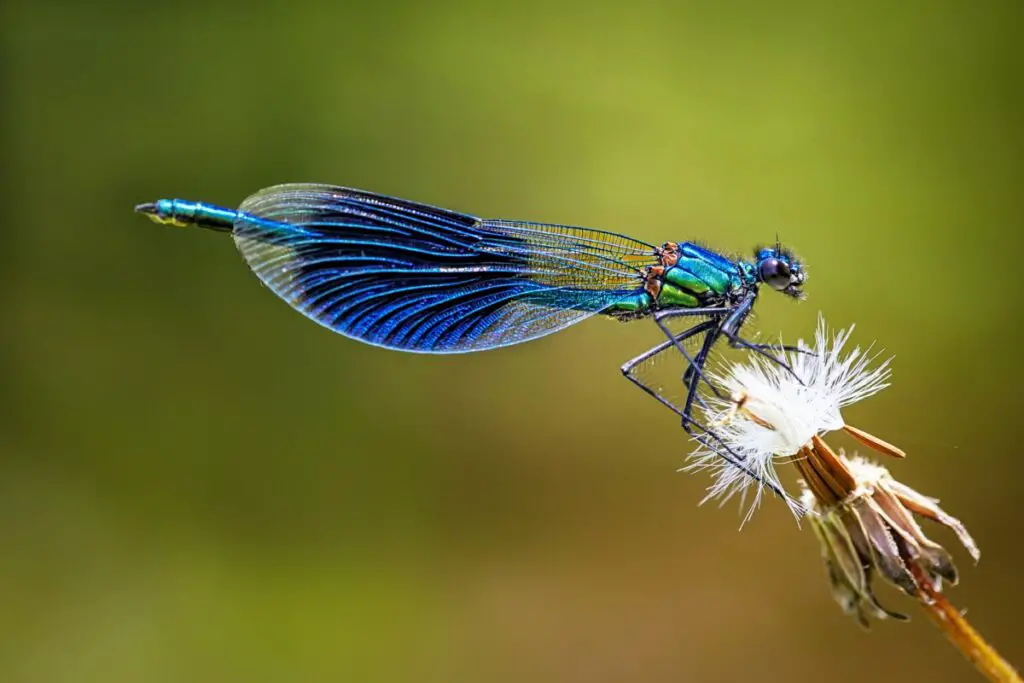
Adult dragonflies can eat more than 100 mosquitoes a day!
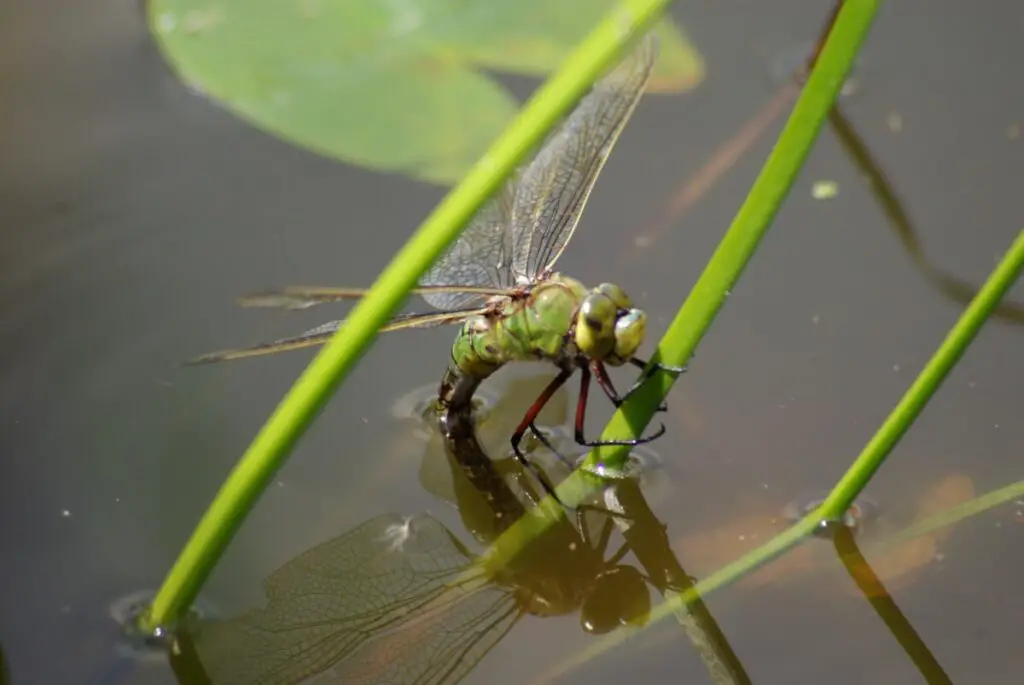
Adult dragonflies will lay their eggs on submerged vegetation and sticks. If these are not available, they will just deposit them into the water.
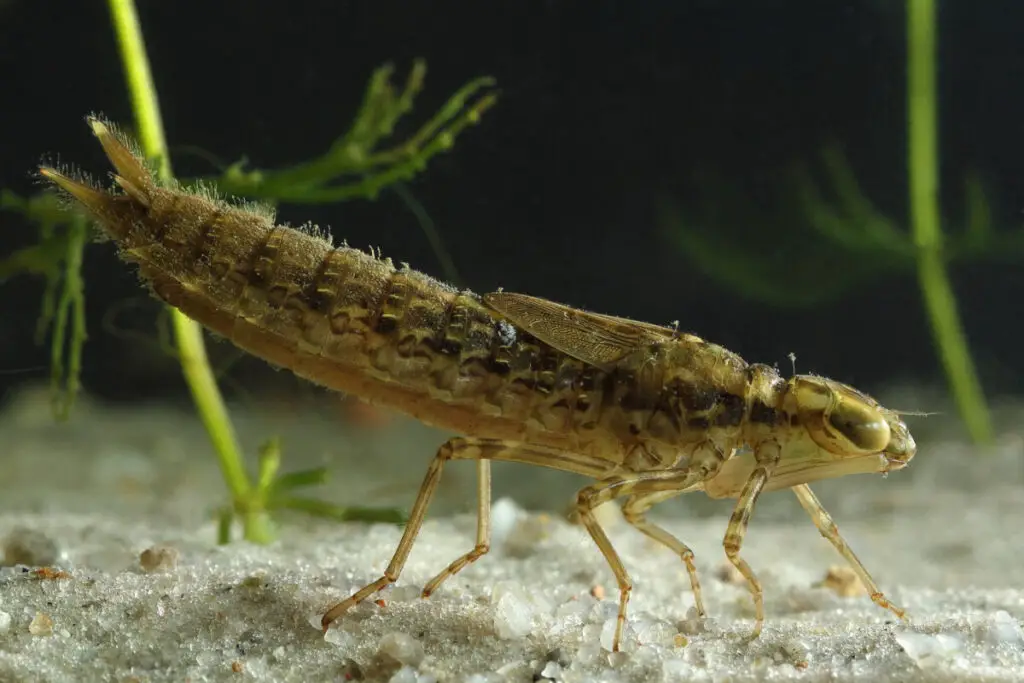
After the egg hatches, the carnivorous nymphs will hunt and consume mosquito larvae.
A dragonfly’s nymph live stage lasts for about one year in warmer climates and up to six years in areas where there are four seasons. That’s a lot of mosquito larvae eating!
Just remember, dragonfly nymphs can also prey on small fish and tadpoles, so be careful if that’s all you have in your pond.
Frog Ponds – How to get rid of mosquitoes in a frog pond naturally
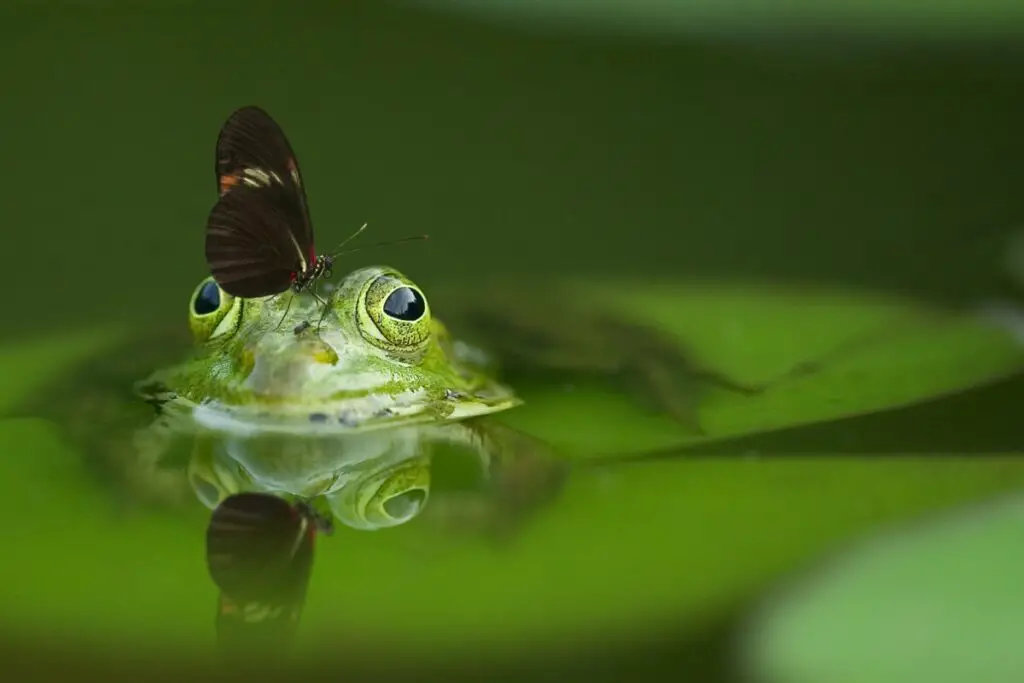
Most species of tadpoles will eat mosquito larvae. However, they are not exactly veracious eaters and should not be relied upon as an effective way of controlling larvae.
However, some species of tadpoles found in North America can actually be quite effective.
The spadefoot toad, green tree frog, and giant tree frog are all known for their tadpoles that eat mosquito larvae. Still, you would need to have a large number of tadpoles swimming in your pond in order to disrupt the cycle of mosquitoes and larvae in it.
Encouraging dragonflies to lay their eggs in your frog ponds is NOT a good idea. While dragonflies and their nymphs are great at getting rid of mosquitoes and mosquito larvae, the nymphs will also eat tadpoles.
For this reason, it’s also a good idea to periodically check that you don’t have any dragonfly nymphs living in your frog pond. As part of your regular cleaning, scoop up any leaf matter and discard it. Debris is a common hiding place for dragonfly nymphs.
Larger mosquito eating fish may also be an issue in a frog pond as they can also eat the tadpoles, or nibble at their tails.
For frogs ponds, the safest and easiest way to get rid of mosquitoes without harming frogs or tadpoles is to use any one of the bacterial larvicides or insect growth regulators detailed in this article.
Why Do Mosquitoes End Up In Your Pond?
To get to the root of the problem, you have to understand how mosquitoes found their way to your pond first.
Mosquitoes prefer to lay and hatch their eggs in stagnant or slow-moving water. Old tires, containers left open, and puddles are just some of the other places that can be a favorite breeding ground for mosquitoes. Since a pond is usually a body of water that is stagnant or is slowly moving, mosquitoes are naturally attracted to it.
All it takes is one mosquito to lay it’s raft of eggs in the water. Once they hatch, the air breathing mosquito larvae take about two weeks before they mature and emerge from the surface of the water as adult mosquitoes. This breeding cycle can repeat over and over and before you may even realize it, you’ve got a swarm of mosquitoes.
Most people, once they realize that their pond has been infested with mosquito larvae, would immediately resort to abandoning the pond or clearing it out entirely and start anew. However, what if there is a way to get rid of these annoying pests without the need to damage your pond, or to have your fish and frogs affected in the process?
Are Mosquitoes A Health Hazard
Uncontrolled infestation of mosquitoes can pose serious health hazards to humans.
Mosquitoes are known carriers and spreaders of several dangerous viruses and parasites, including:
- Dengue virus
- West Nile Virus
- Zika Virus
- Eastern Equine Encephalitis
- Malaria (caused by the Plasmodium parasite)
How Do I Keep Mosquitoes Out Of My Pond?
Keep the water moving
Mosquitoes breed in stagnant or still water. So, your fish or frog ponds will only be attractive to an egg-laying adult mosquito if they remain still for a long time.
If the water is kept moving, it is more difficult for an adult female to lay her eggs. If you do end up with mosquito larvae in your pond, they will not be able to siphon in any air from the turbulent waters surface and eventually they drown.
You can buy some simple but effective devices on Amazon that keep mosquitoes out of your pond and kill any larvae. They work by keeping the surface of the water moving and stop the water stagnating. They include:
- Water bubblers
- Water wriggler
- Pond aerators
However, if you don’t want to run a pump all day and night, your best option is to consistently apply any of the recommended larvicides that are safe for fish and frogs.
They will immediately kill off any larvae that do manage may be starting to settle on your water. This will, in turn, disrupt any cycle that mosquitoes may attempt to build on your pond.
Just don’t forget to do this on a regular basis, or you might wake up one day with a swarm of mosquitoes in your garden, and its eggs in your pond.
Add some natural mosquito predators
Adding mosquito eating fish to your pond and encouraging dragonflies (and their nymphs) to hang out in you pond can also be a very effective and natural way of keeping mosquitoes at bay.
Before You Go
Mosquitoes, without a doubt, are annoying and can be really inconvenient. Not only they are a nasty disturbance (when they bite) and are carriers of disease, they can also turn a beautiful pond into an infested body of water.
However, with the right methods and with proper care, you can beat mosquitoes and claim back your nice and clean pond. Once they’re gone, make sure that they never find their way again to your waters by doing the correct preventive measures!
